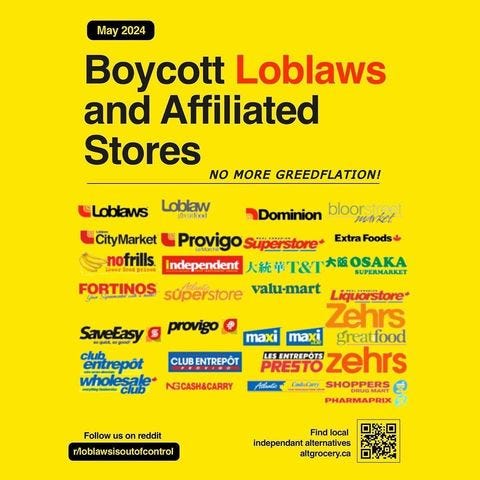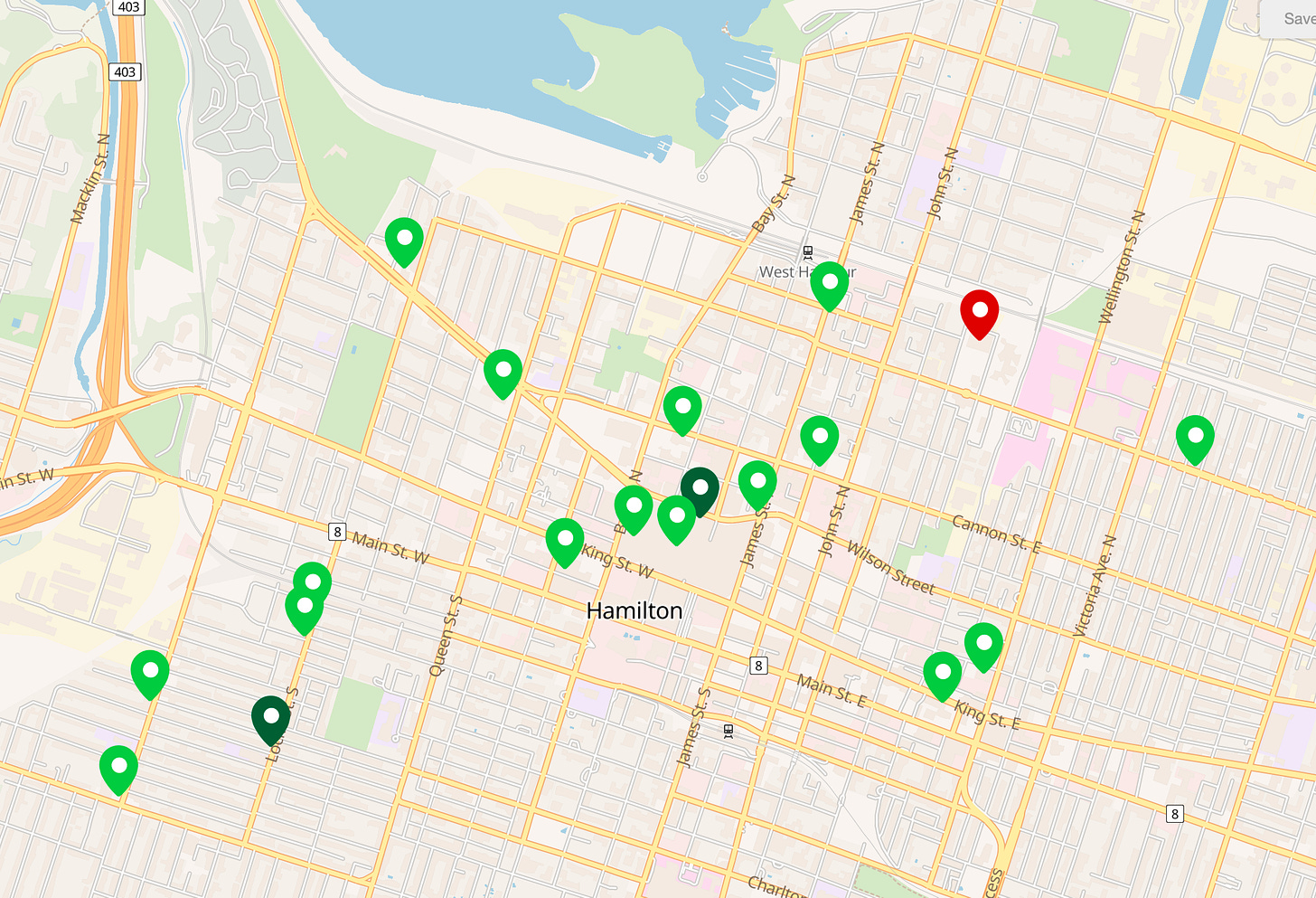foodstuff is a free reader-supported publication that releases new material twice monthly. To receive one essay and one veggie-centred recipe right to your inbox, consider becoming a subscriber. If you’re already a supporter, thank you, thank you, thank you for being here with me!!
If you missed the last issue of foodstuff, check it out: cauliflower sheet salad, wrapped (as I’d like to be)
It’s been a while. Thanks for being patient with me! Between applying for jobs, writing my dissertation and conferencing (not to mention everything else that’s happening in the world) I’ve not had the brainpower to write for foodstuff. But today is May 1st, which means that it is the first day of a coordinated boycott of Loblaw Companies and I wanted to offer something useful for those in Hamilton able to participate, this month and beyond.
What I’ve put together is a map of grocery stores in Hamilton that are not affiliated with Loblaw Companies. I’ll speak to the details of the map itself shortly, but first, some brief context on the boycott.
Grocery Prices in Canada: An Ongoing Issue
For those who’ve been following for a while, you may recall a piece I wrote in April of 2023 called ‘“Reasonable Profitability” and other garbage from the grocery ghouls of Canada.” This piece responded to Canada’s big three grocery CEOs getting “grilled” on grocery inflation by Members of Parliament on the Standing Committee for Agriculture and Agri-Food last year.
of Anthrodish has also written excellent pieces about grocery in Canada. “where do we go next for affordable and accessible food in Canada?” is a piece she wrote in November of last year that is worth a re-read!These readings will help offer some necessary context as to why folks are so frustrated with grocery giants in Canada, particularly Loblaw Companies, which is the largest food retailer in the country
The Boycott of Loblaw Companies, May 2024
Put very simply, the boycott of Loblaw owned companies is a coordinated refusal to support a grocery monopoly that continuously reaps profits while people struggle to buy basic necessities.
Earlier this year, the subreddit r/loblawsisoutofcontrol began gaining traction, reflecting Canadians’ mounting frustration with major grocers, which have been under political and public scrutiny for rising food prices and profits in recent years.
Coordinated by this subreddit, which has over 60K members, the boycott is leverage for demanding the following of Loblaw:
Signing the grocer code of conduct
No further retailer-led price increases for 2024
No further increases to dividends
Increased cost transparency; ie identifying the items which have undergone “shrinkflation”
A commitment to affordable pricing. Ie price caps on essential items
A commitment to ending price gouging, with prices quickly reflecting the market.
You can read more about the origins and purpose of the boycott and/or stay up to date at the following links:
Instagram: @loblawisoutofcontrol
Facebook: Boycott Loblaws
“'Deeply unhappy' grocery shoppers plan to boycott Loblaw-owned stores in May” by Rose Saba
For those who are not able to participate in the boycott itself, you may still be able to participate in other ways, including:
sharing info and posters
writing to your MP using the letter templet offered by the boycott organizers
Mapping Grocery in Hamilton
An important point about the coordinated efforts of this boycott is the recognition that everyone’s participation will look different and will depend upon many factors including income, location, access to transportation, etc.
The very nature of living under conditions of grocery monopoly ensures that boycotts such as these will be inconvenient and inaccessible for many. As such, full participation will not always be possible. However, this reality does not detract from the importance of a boycott (or any coordinated effort targeting an oppressive force). Instead, it emphasizes the need for action—whatever is manageable— against power-wielding corporations that profit off basic needs like food.
In my mapping of Hamilton grocery stores, what I knew to be true in an abstract sense materialized on my screen. By excluding Loblaw owned stores like Fortinos and NoFrills, gaping holes appeared in parts of the city. If I excluded the stores owned by Empire, Metro and Walmart too, I’d have see even more, particularly along the Barton strip, a part of Hamilton where many low-income, racialized, and heavily policed folks are living. Moreover, removing these options in gentrified and gentrifying locations, like the Crown Point neighbourhood, would only leave grocery options beyond the means of the neighbourhood’s lowest income residents.
This is to say that if you’re able to only shop at local or independent grocery spots, go for it, but please recognize that this is not a possibility for many, at least not as we stand in this moment.
I have tried to include a range of grocery options on my map but please, I welcome you to reach out with any concerns or recommendations. I plan to continue adding to this resource; I want to add more farmer’s markets, and farm stalls as the season goes on. I’d also love to include some restaurants, cafes, and snack spots.
THE MAP: HAMILTON GROCERY
For those who are not located in Hamilton, AltGrocery might be a helpful place to start if you are looking for Loblaw alternatives.
Again, thanks for your patience with me as I try to sort out my life! I’ve missed you all and I’ve missed publishing foodstuff regularly.







always so thrilled to see you in my inbox, esp. around this! best of luck with the diss writing too 💕
Thanks for this work! Hope everything else is going well!